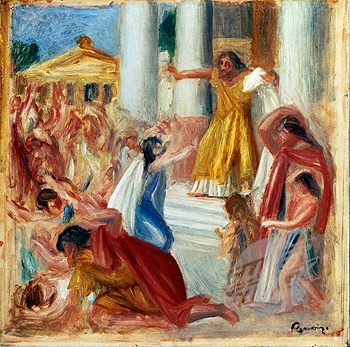In 1977 CBS aired When Television Was Young, a two-hour-long documentary hosted by Charles Kuralt (remember him?) that consisted for the most part of excerpts from kinescope recordings of live TV broadcasts that originally aired between 1949 and 1961. The programs include Captain Kangaroo, CBS Reports, Douglas Edwards with the News, The Edsel Show, The Ernie Kovacs Show, The Garry Moore Show, The Goldbergs, The Honeymooners, Howdy Doody, I Love Lucy, Kukla, Fran and Ollie, The Mickey Mouse Club, Mary Martin and Noël Coward: Together With Music, Mr. I. Magination, Playhouse 90, The Red Skelton Show, See It Now, The $64,000 Question, Studio One, Suspense, Texaco Star Theater, Tom Corbett, Space Cadet, You Are There, and Your Show of Shows. Some anonymous benefactor has posted the whole show on YouTube in seven installments. I commend all seven to your attention.
Don’t be thrown by the fact that the program gets off to such a slow start. Television used to be like that:
Archives for September 2009
TT: Three for three
Pops: A Life of Louis Armstrong has received yet another pre-publication rave, this one in the August issue of Booklist, the magazine of the American Library Association. Here’s an excerpt:
Teachout excels when explaining such things as why the early Armstrong recordings with his Hot Five and Seven groups are cornerstones of jazz. He provides a fresh musician’s perspective when analyzing the strengths and weaknesses of such foundational compositions as “Heebie Jeebies” and “West End Blues.” Teachout also argues for the merits of Armstrong’s popular music done in the manner of Bing Crosby. And he disagrees with the later bebop players who didn’t like Armstrong’s act, which they viewed as pandering to white audiences. What they didn’t understand, and what Teachout vigorously argues while simultaneously revealing the soul of his subject, is that being an entertainer was wrapped up in Armstrong’s personality and genius. Ultimately, Teachout’s fine biography shows how much of Armstrong’s love of music–and people–was behind that signature million-watt smile….
Nice, huh?
* * *
A boy must peddle his book, so I now have a personalized author page at Amazon. To see it, go here.
TT: Almanac
“The dead might as well try to speak to the living as the old to the young.”
Willa Cather, One of Ours
TT: I remember…
…and always will.
TT: Little house in the big woods
In this week’s Wall Street Journal drama column I report on a production of Eugene O’Neill’s Long Day’s Journey into Night at American Players Theatre’s new Touchstone Theatre, plus a revival by Arlington’s Signature Theatre of Claudia Shear’s Dirty Blonde. Here’s an excerpt.
* * *
The recession has swept through America’s regional theaters like swine flu through a kindergarten. A handful of prominent troupes, including Wisconsin’s Madison Repertory Theatre and Massachusetts’ North Shore Music Theatre, have closed up shop altogether, while others are working overtime to stay in business. You can see the fear in their safety-first programming (more musicals, familiar classics like “A Streetcar Named Desire” and small-cast comedies like “Private Lives”) and slimmed-down schedules (I can’t begin to list the companies that are putting on fewer shows this season).
 So it’s big news when a leading American company bucks the trend by opening a new theater. Wisconsin’s American Players Theatre, which already presents five plays each summer in its 1,150-seat hilltop amphitheater, is now putting on a second series of productions in its new Touchstone Theatre, a handsome 200-seat indoor house whose prairie-flavored modern architecture and woodsy surroundings pay graceful homage to Frank Lloyd Wright (Taliesin, his home, is a mile or so away). In contrast to the Shakespeare-Shaw-Coward classical repertory performed in the Up-the-Hill Theater, the Touchstone plans to specialize in contemporary fare, and its initial group of offerings includes two major postwar plays, Eugene O’Neill’s “Long Day’s Journey into Night” and Harold Pinter’s “Old Times.”…
So it’s big news when a leading American company bucks the trend by opening a new theater. Wisconsin’s American Players Theatre, which already presents five plays each summer in its 1,150-seat hilltop amphitheater, is now putting on a second series of productions in its new Touchstone Theatre, a handsome 200-seat indoor house whose prairie-flavored modern architecture and woodsy surroundings pay graceful homage to Frank Lloyd Wright (Taliesin, his home, is a mile or so away). In contrast to the Shakespeare-Shaw-Coward classical repertory performed in the Up-the-Hill Theater, the Touchstone plans to specialize in contemporary fare, and its initial group of offerings includes two major postwar plays, Eugene O’Neill’s “Long Day’s Journey into Night” and Harold Pinter’s “Old Times.”…
 I found APT’s production to be more convincing than the 2003 Broadway revival, though I suspect the fact that it was being presented in a 200-seat thrust-stage house instead of an 1,100-seat proscenium-stage Broadway theater had something to do with its effectiveness. “Long Day’s Journey” is, after all, a five-character, one-set play, and even though four of the characters are members of a theatrical family, their intramural sniping is easier to take–and to sympathize with–when presented on the unexaggerated scale enabled by the Touchstone Theatre and encouraged by John Langs, the director of this production. This is the first time I’ve seen “Long Day’s Journey” in a small house, and I’m inclined to think that it should always be done that way….
I found APT’s production to be more convincing than the 2003 Broadway revival, though I suspect the fact that it was being presented in a 200-seat thrust-stage house instead of an 1,100-seat proscenium-stage Broadway theater had something to do with its effectiveness. “Long Day’s Journey” is, after all, a five-character, one-set play, and even though four of the characters are members of a theatrical family, their intramural sniping is easier to take–and to sympathize with–when presented on the unexaggerated scale enabled by the Touchstone Theatre and encouraged by John Langs, the director of this production. This is the first time I’ve seen “Long Day’s Journey” in a small house, and I’m inclined to think that it should always be done that way….
Claudia Shear rang the bell in 2000 with “Dirty Blonde,” which ran for 352 performances on Broadway. Now it’s being revived by Signature Theatre, the Washington, D.C.-area company that won this year’s regional-theater Tony Award. With “Restoration,” Ms. Shear’s latest play, set to move from the La Jolla Playhouse to Off Broadway this spring, I thought it would be interesting to see how “Dirty Blonde” had held up–and I’m pleased to report that it’s still a gem….
* * *
Read the whole thing here.
TT: Almanac
“After all, one knows one’s weak points so well, that it’s rather bewildering to have the critics overlook them & invent others that (one is fairly sure) don’t exist–or exist in a less measure.”
Edith Wharton, letter to Robert Grant (Nov. 19, 1907)
TT: Don’t listen, Mom!
 Vanity Fair is going to be posting a pair of “audio excerpts” from Pops: A Life of Louis Armstrong on its Web site later this fall, so I spent the morning taping them. In one of the two passages, Armstrong repeatedly uses a twelve-letter word that has never appeared on this blog but is part of the working vocabulary of many jazz musicians. I read it into the microphone five times in a row without blinking an eye, and as I did so, it occurred to me that my own mother, who has never heard me use such language, might not approve.
Vanity Fair is going to be posting a pair of “audio excerpts” from Pops: A Life of Louis Armstrong on its Web site later this fall, so I spent the morning taping them. In one of the two passages, Armstrong repeatedly uses a twelve-letter word that has never appeared on this blog but is part of the working vocabulary of many jazz musicians. I read it into the microphone five times in a row without blinking an eye, and as I did so, it occurred to me that my own mother, who has never heard me use such language, might not approve.
Fortunately, my mother doesn’t have a computer, so I think I’m in the clear. Nevertheless, I hope nobody tips her off that her son is going to be talking dirty on the Internet….
TT: So you want to see a show?
Here’s my list of recommended Broadway, off-Broadway, and out-of-town shows, updated weekly. In all cases, I gave these shows favorable reviews (if sometimes qualifiedly so) in The Wall Street Journal when they opened. For more information, click on the title.
Warning: Broadway shows marked with an asterisk were sold out, or nearly so, last week.
BROADWAY:
• Alfred Hitchcock’s The 39 Steps (comedy, G, suitable for bright children, reviewed here)
• God of Carnage * (serious comedy, PG-13, adult subject matter, reviewed here)
• South Pacific * (musical, G/PG-13, some sexual content, brilliantly staged but unsuitable for viewers acutely allergic to preachiness, reviewed here)
OFF BROADWAY:
• The Fantasticks (musical, G, suitable for children capable of enjoying a love story, reviewed here)
• Our Town (drama, G, suitable for mature children, reviewed here)
IN ASHLAND, OREGON:
• The Music Man (musical, G, very child-friendly, closes Nov. 1, reviewed here)
IN CHICAGO:
• The History Boys (drama, PG-13/R, adult subject matter, too intellectually complex for most adolescents, extended through Oct. 18, reviewed here)
IN SPRING GREEN, WIS.:
• Henry V (Shakespeare, G, closes Oct. 2, reviewed here)
IN STRATFORD, ONTARIO:
• The Importance of Being Earnest (comedy, G, closes Oct. 30, reviewed here)
• Three Sisters (drama, PG-13, closes Oct. 3, reviewed here)
CLOSING SOON IN SPRING GREEN, WIS.:
• The Winter’s Tale (Shakespeare, PG-13, closes Sept. 26, reviewed here)
CLOSING SOON IN TOPANGA, CALIF.:
• The Cherry Orchard (drama, PG-13, adult subject matter, closes Sept. 26, reviewed here)
CLOSING NEXT WEEK IN EAST HADDAM, CONN.:
• Camelot (musical, G, closes Sept. 19, reviewed here)
CLOSING SUNDAY ON BROADWAY
• Avenue Q * (musical, R, adult subject matter and one show-stopping scene of puppet-on-puppet sex, reviewed here)
